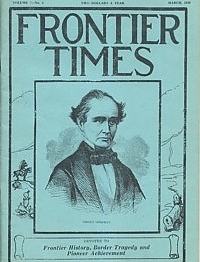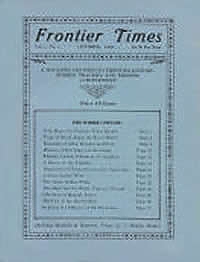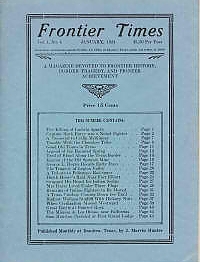By using our website, you agree to the use of cookies as described in our Cookie Policy
Magazines & Instant Downloads
Vol 07 No. 06 - March 1930
A Hero Of San Jacinto
Account of SIDNEY SHERMAN, a native of Massachusetts, who came to Texas when the call for volunteers for Texas indepencance rang forth. He abandoned his business, raised and equipped a company of fifty men, and started for the theater of war. He arrived on the Brazos in February, and hurried forward to Gonzales, intending to go to the relief of Travis, who was then shut up in the Alamo, but failed to get a sufficiently large force to justify him in the undertaking. At the organization of the first regiment at Gonzales Burleson was elected colonel and Sherman lieutenant colonel. When the army reached the Brazos another regiment was organized, of which Sherman was elected colonel. He and his family settled upon the San Jacinto Bay, where he resided for several years. In 1842 he was elected a representative in the Texas Congress for Harris county. This is his story.
Further Mentions: General Rusk * Commodore Moore * rebuilding the town of Harrisburg * the ill-fated steamer Farmer.
LIVES IN ROOM IN WHICH HE WAS BORN 74 YEARS AGO
Account of James L. Duggar, whose lived four miles east of McKinney, all his life in the same house. During his long life Mr. Duggar had never been outside the State of Texas, in fact had never been over 100 miles from home, and has never been away from home more than three nights at a time. Mr. Duggar's parents moved from Maury county, Tennessee, to Texas in 1852. Two years later his father bought the 100 acres of land where Mr. Duggar lived. In 1854 the old Duggar home was built. It consisted of one room, sixteen by eighteen feet, and was built of postoak lumber hewed out by hand.
David Crockett
An Address of Claude Pollard Attorney General of Texas describing the wild and wondrous life of David Crockett.
"He impressed his life upon millions and no man can do this unless there is something worthy of the most serious consideration, both in his character and career. His life is a romance intermingled with indisputable truth. He lacked he refinements of education, and did and said many things which may not be models for the youth of the land, but rough and uncultured as he was there is much that is worthy of commendation and imitation" This is the story.
Remember The Old Water Mills?
T. Jackson.
Water mills and millstones were immensly importatnt in the pioneer days. They represented an important and vital part of life and technology. This is theaccount of numerous old water mills from pioneer days.
Mentions: The millstone was presented to the Alamo by Messrs, Frank Grice and Nat Lewis * On June 6, a Mormon colony made its first substantial settlement in Texas. The location was on the Colorado river at the foot of Mount Bonnell, near Austin. The men immediately set about building the first power-driven grist and lumber mill known in that section. For a year the mill operated there, and was a boon 'to settlers in the surrounding country. Until then settlers had been grinding corn on small steel hand mills. The advent of this water mill made them feel that civilization was approaching * the City of Zodiac, located on the Pedernales river * town of Fredericksburg * Old photo of Remains of Finlay Mill on the Llano river * Lyman Wight, the devout leader of the Mormon colony * a location on Hamilton creek, in Burnet county * the Lange mill in the Doss community, on Threadgill creek, in the northwestern part of Gillespie county * On the south bend of the Llano river, some ten miles west of the town of Llano, stand the remains of an old water mill built by J. K. Finlay in the early 1870’s* A noted natural swimming pool, known as the "Blue Hole," is located near this old mill * Giles' mill at Bosqueville, six miles north of Waco * Two millstones, claimed to be among the oldest in East Texas, are to be seen on the old settlers' reunion grounds at Quitman * In 1851 those millstones were brought to Wood county by a settler named Gunstream * E. Lederman * overshot water mill, located on Lake Fort * the town of Mineola * Two-Mile branch * John Long and Dr. Patton * Salado * Salado Springs * Davis mill * Colonel Jones mill, Stinnett mill, Ike Jones mill, Ferguson mill, Dulaney mill, Summers mill and Mote Smith mill * The Davis mill * The Dulaney mill * John T. Dulaney * The Summers mill * John Meyers * D. C. Summers * Rev. James (Uncle Jim) Ferguson one of the first circuit riders in Bell county * Alva Ferguson * J. R. Holland * The Mote Smith mill * Bill Holmes * three Holmes brothers.
TEMPLE WOMAN BORN BEFORE TEXAS FREEDOM
Account of Mrs. Amanda Fetterly, of Temple, Texas, who lived in Texas before Texas gained her independence and became a republic. She was born on September 12, 1835, on Polygoch, Creek, in Sabine county. She had lived in Texas 170 days before the Texas Declaration of Independence was signed. Mrs. Fetterly's father, Benjamin Bryant, was a native of Wilkes county, Georgia, where he was born in 1802, later moving to South Carolina. In 1834 he came to Texas with his family, crossing the Sabine river at Sabine Ferry. They acquired land in Sabine county, and here their daughter, now Mrs. Fetterly, was born.
Battle Of The Caves
By L. D. Walters.
Account of events that occurred in the fall of 1873 when the Tonto Apaches became exceedingly active in their operations up and down the Salt River Valley, in the north central portions of Arizona. They dealt out all kinds of misery to the few scattered white settlers located along the river, stealing horses and cattle as well as taking toll of human life whenever opportunity offered and enjoying themselves to the limit. In December of that year General Crook took personal command of the troops in the field and started out to clean house insofar as the Tonto Apaches were concerned. This midwinter campaign was a veritable running fight for days and the Tontos were slowly but surely losing ground as well as warriors.
On the 28th day of December, the main party of Tontos, being closely pursued by troops, took refuge in a large mouthed cave far up in the Salt Canon. Rocks had been piled along the edge of the shelf in front of the cave mouth and behind these breast works the Tontos proceeded to pick off the soldiers one by one. This event precipitated what became know as the "Battle of the Caves"
Darkey Of Old School Passes Century Mark
By Oran Warder Nolen.
Account of Tom Sullivan of Pearsall, TX, one of the most remarkable characters in Southwest Texas. He lived past the age of 105, and in this account tells of notable experiences on the frontier, and during the Civil War and beyond.
"People died so fast they couldn't dig graves for them. They just dug a long trench, on the beach north of town and buried them in it. When any one ill, with yellow fever began to spit black spit they was done for. In some cases they were put in boxes before they quit moving. I had to help take two girls 'off of beds and put them in boxes before they quit moving. Only the people who had been living there a long time was affected. Those who were from outside like I was wasn't taken sick with the yellow fever."
Further Mentions: Aunt Jane, his wife * Medina and Frio counties * Henrietta Washington * Tubby Creek, ten and a half miles north of Abilenm, in Monroe County * Aaron Redus * Mr. Bill Redus moved to Texas in 1848 or 1849 and settled on Hondo Creek in Medina County * Mr. Ben Duncan * Captain Owens * Tom Malone * Mr. Ketchum * Mr. Rube Smith * Kim Smith * Camp Verde * Moore Station * Dr. Speed * Pearsall Dow * Bud Walker * Mr. Walker * Judge George Noonan * Mr. Vance * Powder Horn * prairie north of Yorktown * Captain Wallace * August Kemp, County Clerk at Hondo * King Fisher * Captain Wallace * Ben Thompson * Ben Duncan * John Wesley Hardin * Frio Town * Jim Harkness * Jenny Lind * Otto Goldschmidt * John' Struthers * Eli Harris * Horatio Bigelow * General James Long
The So-Called "Confession" Of Tom Horn
By Charles H. Coe
Tom Horn, "King of the Cowboys," valued Government scout and interpreter under Generals Crook and Miles in the various campaigns after Geronimo, the noted Apache chief, later famous cowboy on Arizona ranches and the deputy of three sheriffs of that State, and lastly cowboy and cattle detective in Wyoming. This account is a sequel to the January, 1930 Frontier Times lengthy and detailed account of the events of his life including his arrest, trial, imprisonment and subsequent efforts to clear his name. This story deals specifically with his supposed "confession" to the crime of murdering a 14 year-old boy.
Further Mentions: John Clay * Josh Billings * John C. Coble * Al Bowie * Doc (C. W.) Shores * Willie Nickell * Rev. Williams * Deputy Sheriff ' Proctor * Kels Nickell * Mr. Durke one of Tom's lawyers
"The Law West Of Pecos"
MUCH HAS BEEN said and written about old Judge Roy Bean, "the Law West of the Pecos," some of it true and some of it untrue. Bean was quite a character, and for a long period, of time was all that he claimed to be, "the Law, out west. Mere lack of jurisdiction never worried Roy Bean. Although without legal authority he tried men for murder, highway robbery and other district court cases, and saw to it that his convictions were carried out. This is the man’s story.
Ordinarily the Southern Pacific train stopped at Vinagaroon but a few minutes, but the Conductor obligingly held his train one hour for the Jersey Lily, as she was known. Bean was much impressed, showed a wide smile through his thick whiskers and decided to hold a special court in honor of the actress. A Mexican was charged with assault to murder, a jury of border cowboys found him guilty and Bean gave him a sentence of six months' imprisonment. Lily Langtry presented the old justice with a photo of herself and so charmed him that he announced there and then that the name of the town thereafter would be Langtry. He placed the photo on a shelf beside a copy ' of the Texas revised statutes, many years out of date, but which never concerned Bean.
None of Bean's prisoners ever went to the penitentiary. Instead they worked out their sentences around the Bean place.
The court was his own bartender. When the hour came for a session Bean would warn customers to get their drinks, remove his apron, walk around in front and announce the session had begun.
"Anyone want a drink before court opens?" he always asked. "I can't adjourn court to get any for you fellers. "
If a trial appeared somewhat lengthy Bean would recess court every half hour to enable everyone to quench his thirst. Everyone "quenched" to be on the good side of the court.
When a railroad bridge worker was accidently killed, Judge Bean held an inquest. Searching the body he discovered a pistol and $48 in cash. Bean was equal to the occasion. He immediately fined the corpse $48 for carrying concealed weapons and pocketed the money.
Account Of Texas Pioneer Days
Mary Daggett Lake.
Mentions: Howard Peak * Dr. and Mrs. C. M. Peak among the very earliest of Tarrant County's first 100 families * Kitty Barry * Mahneke House * the Gunter Hotel in San Antonio * Generals Sherman, Worth, Grant, Lee, Twiggs, Thomas and Van Dorn * Rev. Isomer T. Wilson, Wiley Blair and Hubb Diggs.
Texas Indians Were Cannibals
By Dr. R. W. Noble, in Houston Chronicle Sunday, December 1, 1929
Further Mentions: Capt. J. Tilford Whiteside * Navasota * Wallace Prairie * West Academy * His home was called Sycamore Grove * 'Tennessee, near McMinville * George Pendleton of Bell County * Rev. Alpha Young of San Marcos * Moses G. Noble * Mrs. Whiteside and his step-daughter, Mary Wood * Mr. Weir of Hempstead * Doctor Lockhart home * Frank and J. Tilford * the old Graball road * Walnut Creek * Courtney * Smithville * Carankawas * Lorena, Texas * H. E. Dunlap * Major W. M. Green * R. N. Gary *
Realizing he was safe he lay still. After some gunfire, and a few more hoops, he could hear only Indians talking. After the sun came up an Indian stood on the bluff and looked down…just over his head and the insects buzzed around him, but he was afraid to move. The sun went over to the west. He was nearly dead of thirst, but it was not safe to stir. At last the sun set, then he freed himself of the friendly vines and climbed down. the tree, found the creek, lay down on his, stomach and drank his fill. Regaining the bank of the creek, he, felt his way in the darkness down to the mouth of the branch. Striking the buffalo trail, he got down on his hands and knees so that he wouldn't make any noise. He crawled until he reached the top of the bluff and looked over towards their camp. He saw nothing. There was a small moon shining. He could hear nothing, but he was afraid to stand up. While planning what best to do, he heard a low whistle, waited awhile, then he heard it again; it was human: Was it a friend or foe?…had been stripped of his clothing; he was scalped and his body was mutilated. Not a vestage of their equipment was left. Their horses were gone. All were 'barefooted; they, had no guns. They searched the branch and found a small cave under a bluff. They carried their dead companion and laid him there. With sharp sticks they carved off the edge of the…The Indians were roasting the dead man's flesh over a fire.
Its Glory Gone, Tombstone Slips Into Obscurity
Account of old Tombstone, "the wickedest city in the Southwest," capital of Cochise County, Arizona, which was named for and by the wildest Apache Indian murderers. In it’s raucous days of "glory", it gained the reputation as being the liveliest city between the Mississippi and the Pacific. This is the story.
Further Mentions: Bisbee * Gen. John C. Greenway * the Bird Cage theatre * Crystal Palace saloon * the Tombstone Epitaph * Alfred Henry Lewis * Jake Swartz * Chief Geronimo * Gen. Nelson A. Miles * Gen. Crook * Frank Quantrell * Waterville * Edward Schieffelin * the Lucky Cuss and the Tough Nut * Wyatt Earp * Morgan Earp * The Earp-Clanton feud * the O. K. corral * brothers Morgan and Virgil * Ike and Billy Clanton * Frank and Tom McLowery * The Oriental saloon * the Bird Cage theatre and bar * the CanCan cafe * the Million Dollar Stope * William and Lottie Hutchinson * Eddie Foy * Lotta Crabtree * Henry Schneider * Skeleton Canyon * San Simon * "Old Man Clanton," * Doc Holliday. Dick Gray, Billy Land * Sam Purdy * John Dumbar, and Pat Hamilton.
Dead Shots Shot It Out For Buffalo Hunt Title
Account of a contest for best shot between buffalo hunters, R. W. F. Carver, probably the best known rifle shot the world has ever seen, and "Buffalo" Curley (the name given to Jack McCall, who afterward, in Deadwood, shot Wild Bill Hickok in the back of the head). The reputation of Buffalo Curley as a horseback shot was the best on the southern plains and an intense rivalry sprang up between his outfit and the Carver group which led to the challenge to Carver to shoot it out for $500 a side.
"The day of the contest the buffalo came marching in for water early in the morning in great droves, led by a cow. Their long fur coats covered with frost glistened and shone in the sun like small mountains of colored precious stones. At last with a mighty rush they plunged into the waters of the Frenchman by thousands. This was the signal agreed upon. Seven men on horseback rode slowly up the canyon leading out on the plain. In this party were Dr. Carver, Buffalo Curley, two Indians and the referee and judges. The two Sioux on their buffalo ponies had been chosen as markers for the contestants, one with red-feathered arrows for Carver, and one with blue-feathered arrows for Curley.
A pistol shot was fired to scare the buffalo and start them moving and the next instant the herd ran madly up the canyon and came out on the divide within a few yards of the party waiting for them. Half or more of them were allowed to pass when the referee fired a pistol as a signal to start the race. The first shot was fired by…"
Further Mentions: camp at Mud Springs * Calamity Jane * the mouth of Red Willow * Mr. Byfield * Fort McPherson and Lieutenant Schwatka * Eva Raymond
Helen Daggett Famous In Texas History
By Mary Daggett Lake
Account of Helen Daggett and Colonel Watt Moorman, and the romance that connected the lives of these two illustrious characters.
Prior to their marriage Watt Moorman was strangely and powerfully influenced by Helen Daggett. She was his "guiding star", so to speak, and, he was completely dominated by her strong and charming personality. In fact, for a period of several months, the Regulator forces were either directly or indirectly under her complete control. She planned their battles, acted as a spy, was in many of their fights, and often led their attacks.
Further Mentions: the old Bella Vista Road, long since discarded, between Tenaha and the town of old Shelbyville in Shelby County * John Daggett, the grandfather of Helen * Her father, Eleazer Daggett * Elizabeth Cronk of Queenstown, Canada * Fort Brown * Lundy's Lane, Black Rock * Batavia * Lewiston * Vigo County, Ind * Colonel Charles Watson (Watt) Moorman * the southern edge of Panola County * the Flat Fork of the Tenaha River, about mid-way between Center and Tenaha, where Cedar Yard church and school is now located * "Helen's Defeat" * George L. Harris * William Mcray * Ellis County * . M. Daggett * Father of Fort Worth * Tarrant County * Mrs. Simon Farrar * McKee * Isaac Van Zandt * Thomas J. Rusk * Mount Olivet Cemetery * Rev James C. Wilson, a veteran of the Mier expedition * Mr. Wilson settled in Brazoria county * Alexander Somervel
$4.95
‹ Back








